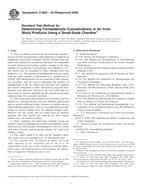We need your consent to use the individual data so that you can see information about your interests, among other things. Click "OK" to give your consent.
ASTM D6007-02(2008)
Standard Test Method for Determining Formaldehyde Concentration in Air from Wood Products Using a Small Scale Chamber
STANDARD published on 1.10.2008
The information about the standard:
Designation standards: ASTM D6007-02(2008)
Note: WITHDRAWN
Publication date standards: 1.10.2008
SKU: NS-33402
The number of pages: 8
Approximate weight : 24 g (0.05 lbs)
Country: American technical standard
Category: Technical standards ASTM
Annotation of standard text ASTM D6007-02(2008) :
Keywords:
airborne, chromotropic acid analysis, formaldehyde concentration in air, small chamber, small-scale test, wood products, Airborne chemicals, Chromotropic acid analysis, Formaldehyde, Small chamber testing, Wood products, ICS Number Code 13.040.20 (Ambient atmospheres)
Additional information
| Significance and Use | ||||||||||||||||||||||
|
Limitations on formaldehyde levels have been established for wood panel building products made with urea-formaldehyde adhesives and permanently installed in homes or used as components in kitchen cabinets and similar industrial products. This test method is intended for use in conjunction with the test method referenced by HUD 24 for manufactured housing and by Minnesota Statutes for housing units and building materials. This test method provides a means of testing smaller samples and reduces the time required for testing. Formaldehyde concentration levels obtained by this small-scale method may differ from expected in full-scale indoor environments. Variations in product loading, temperature, relative humidity, and air exchange will affect formaldehyde emission rates and thus likely indoor air formaldehyde concentrations. This test method requires the use of a chamber of 0.02 to 1 m3 in volume to evaluate the formaldehyde concentration in air using the following controlled conditions: Conditioning of specimens prior to testing, Exposed surface area of the specimens in the test chamber, Test chamber temperature and relative humidity, The Q/A ratio, and Air circulation within the chamber. |
||||||||||||||||||||||
| 1. Scope | ||||||||||||||||||||||
|
1.1 This test method measures the formaldehyde concentrations in air from wood products under defined test conditions of temperature and relative humidity. Results obtained from this small-scale chamber test method are intended to be comparable to results obtained testing larger product samples by the large chamber test method for wood products, Test Method E 1333. The results may be correlated to values obtained from Test Method E 1333. The quantity of formaldehyde in an air sample from the small chamber is determined by a modification of NIOSH 3500 chromotropic acid test procedure. Other analytical procedures may be used to determine the quantity of formaldehyde in the air sample provided that such methods give results comparable to those obtained by using the chromotropic acid procedure. However, the test results and test report must be properly qualified and the analytical procedure employed must be accurately described. 1.2 The wood-based panel products to be tested by this test method are characteristically used for different applications and are tested at different relative amounts or loading ratios to reflect different applications. This is a test method that specifies testing at various loading ratios for different product types. However, the test results and test report must be properly qualified and must specify the make-up air flow, sample surface area, and chamber volume. 1.3 Ideal candidates for small-scale chamber testing are products relatively homogeneous in their formaldehyde release characteristics. Still, product inhomogeneities must be considered when selecting and preparing samples for small-scale chamber testing. 1.4 The values stated in SI units are the standard values. Any values given in parentheses are for information only. 1.5 This standard does not purport to address all of the safety concerns, if any, associated with its use. It is the responsibility of the user of this standard to establish appropriate safety and health practices and determine the applicability of regulatory limitations prior to use. |
||||||||||||||||||||||
| 2. Referenced Documents | ||||||||||||||||||||||
|
We recommend:
Technical standards updating
Do you want to make sure you use only the valid technical standards?
We can offer you a solution which will provide you a monthly overview concerning the updating of standards which you use.
Would you like to know more? Look at this page.




 Cookies
Cookies
